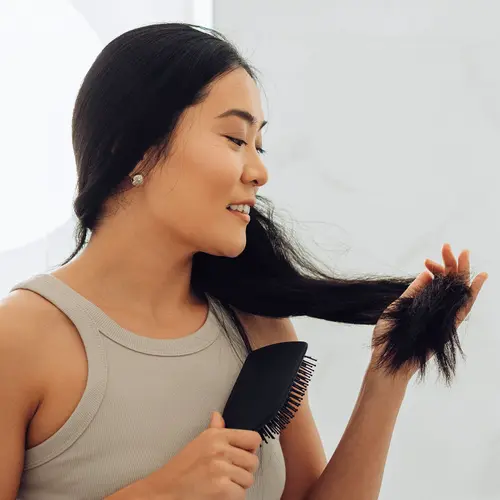Hair dye is a chemical product for treating her, with each combination of chemicals creating a specific color. If these chemicals go bad in some way, the color doesn’t turn out as planned. To help prevent this, most manufacturers put expiration dates on hair dye.
What Is Hair Dye Made Of?
Hair dye is a combination of chemical compounds, and these compounds will vary based on the manufacturer and color of the hair dye. Hair dye works through a series of different chemical reactions. The most common ingredients in hair dye include:
- Ammonia (NH3): Ammonia is a naturally-occurring gas that can be found in air, soil, water, plants, and humans. Ammonia is used in a variety of industries, including agriculture and manufacturing. It’s a common ingredient in household cleaning products. Ammonia helps lighten hair and open up the pores in your hair so the color can penetrate the hair shaft. It also raises the pH of the hair dye to be more alkaline, which helps facilitate color-changing chemical reactions.
- Hydrogen peroxide (H2O2):Hydrogen peroxide is a chemical compound commonly found in households for cleaning, disinfecting, and removing stains. Hydrogen peroxide strips hair of its natural color, allowing the new color to be visible, and helps some of the other chemicals bond together properly to create the right color.
- Paraphenylenediamine (PPD, p-Phenylenediamine, C6H4(NH2)2): PPD is a compound that is naturally colorless. When it’s oxidized, often by hydrogen peroxide, it produces brown dye molecules. It can also create other colors by interacting with other chemicals.
Does Hair Dye Expire?
The chemical compounds used in hair dye don’t last forever. They may break down or evaporate over time. For example, hydrogen peroxide has two hydrogen molecules and two oxygen molecules. This gives it nearly the same formula as water but with an extra oxygen molecule. This extra oxygen is what gives hydrogen peroxide its oxidizing power. Over time, that extra oxygen molecule breaks down. When that happens, it's turned into water, and no longer has the special properties of hydrogen peroxide.
Because the chemical compounds used in hair dye don’t last forever, expired hair dye won't usually give the desired effect. While companies are not obligated to put expiration dates on cosmetic products, they often do anyway because they’re responsible for the safety of their products. Cosmetic products, including hair dye, usually include two types of expiration dates: the shelf-life expiration date and the opened expiration date.
The shelf-life expiration date is often on the product packaging. This date tells you how long the product is good for if it isn’t opened. While the product may still work after this date, it may be less effective.
The other hair dye expiration date is usually on the product itself. Instead of an actual date, this may be a small symbol that looks like a cosmetics container with a number in it, often followed by the letter M. The M stands for months, and the number indicates how long the product is good for after you open it.
If you’re using a boxed hair color kit that has both a dye and developer, they may both have individual expiration dates. Check both of them before you use the kit. If you’ve already mixed all the dye and developer together, you can’t keep whatever is left. You’ll have to throw it out.
Is Hair Dye Safe?
There's been a lot of debate over the years about the safety of hair dye. Some people may be especially sensitive to ingredients in hair dye, causing immediate reactions, such as:
- Contact allergies and hair loss. Contact allergies are allergic reactions that occur when something irritating touches your skin. Contact allergies from hair dyes can irritate the scalp and skin of the face and hands and can lead to hair loss. P-phenylenediamine 1 is often the culprit in these cases.
- Asthma and respiratory reactions. Many people aren't fans of the smell of hair dye, and there's a reason: the ammonia and chemicals can irritate our respiratory system. Hairdressers, especially, can suffer from the effects of inhaling hair dye. If you're dying your hair at home, make sure you're in a well-ventilated space.
- Poisoning. Hair dye is incredibly toxic to consume, and swallowing it can lead to many different health problems. People who swallow hair dye will likely die unless they receive medical care immediately.
- Hormone disruption. While tests haven't been run on humans, tests on animals have demonstrated that some of the ingredients in hair dye could affect embryo development and disrupt the body's ability to make thyroid hormones.
There's also a risk of longer-term effects, like cancer.
- Bladder cancer. It was once thought that the rise in bladder cancer could be attributed to hair dye, but studies have shown that that's most likely not the case.
- Breast cancer. Some studies have indicated that some of the chemicals in hair dye could increase the risk of breast cancer. Further study is needed.
- Hematopoietic cancer. Cancers of the blood have become more common in recent years. So far, studies have had conflicting results as to whether hair dye may contribute to this rise.
In general, using hair dye is safe, but if you're prone to allergies or have sensitive skin, it should be used with caution.
How to Dye Hair Safely
To prevent health issues from hair dye, the Food and Drug Administration recommends the following:
- Follow all the instructions in the package
- Test a small bit of dye on the inside of your elbow to make sure you aren't allergic to it before dying your hair
- Never dye eyelashes or eyebrows at home
- Don't leave the dye on longer than the directions recommend
- Rinse your scalp thoroughly after dying your hair
- Wear gloves when you apply hair dye
- Never mix hair dye products
- Keep hair dye out of the reach of young children


